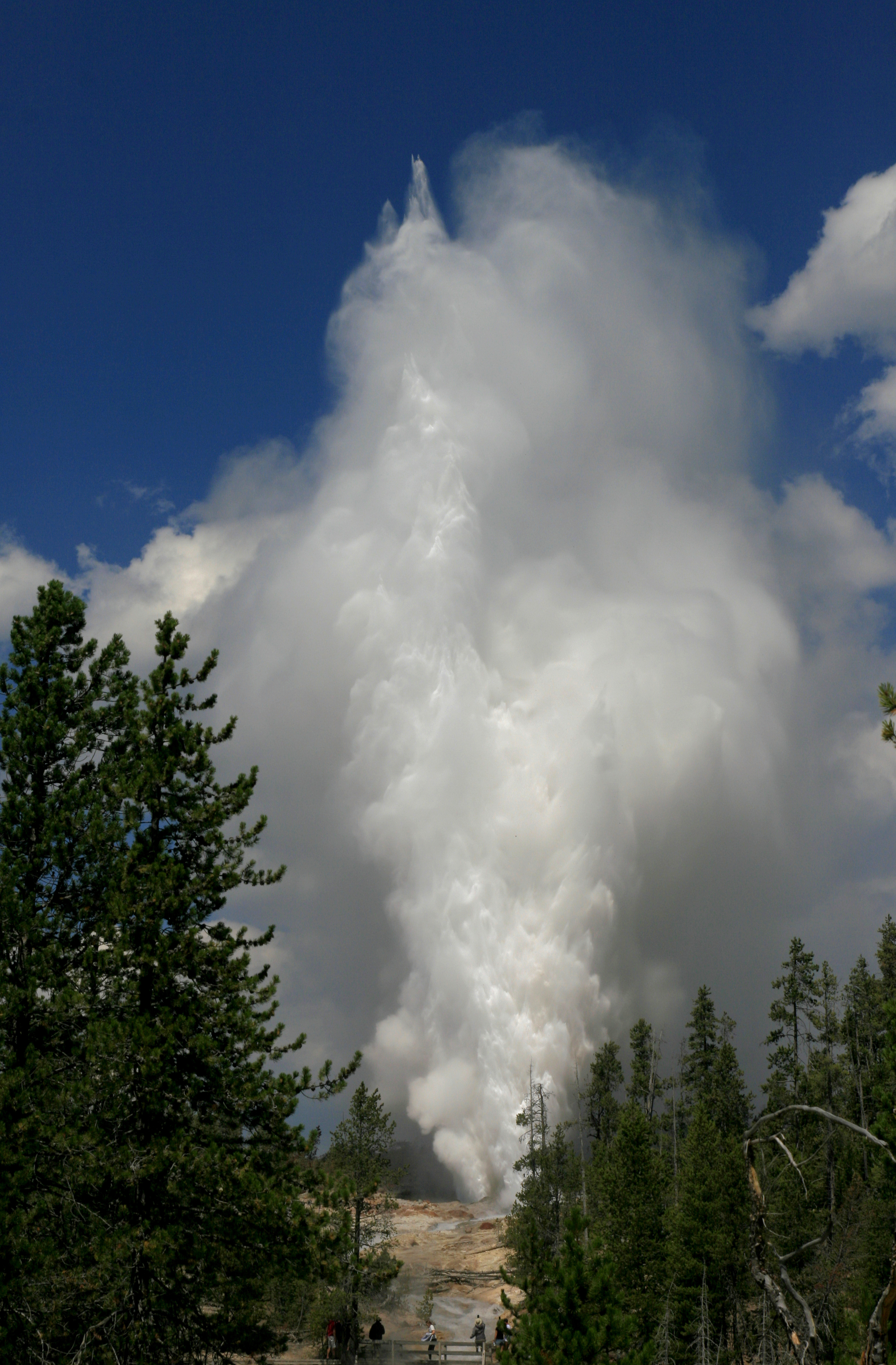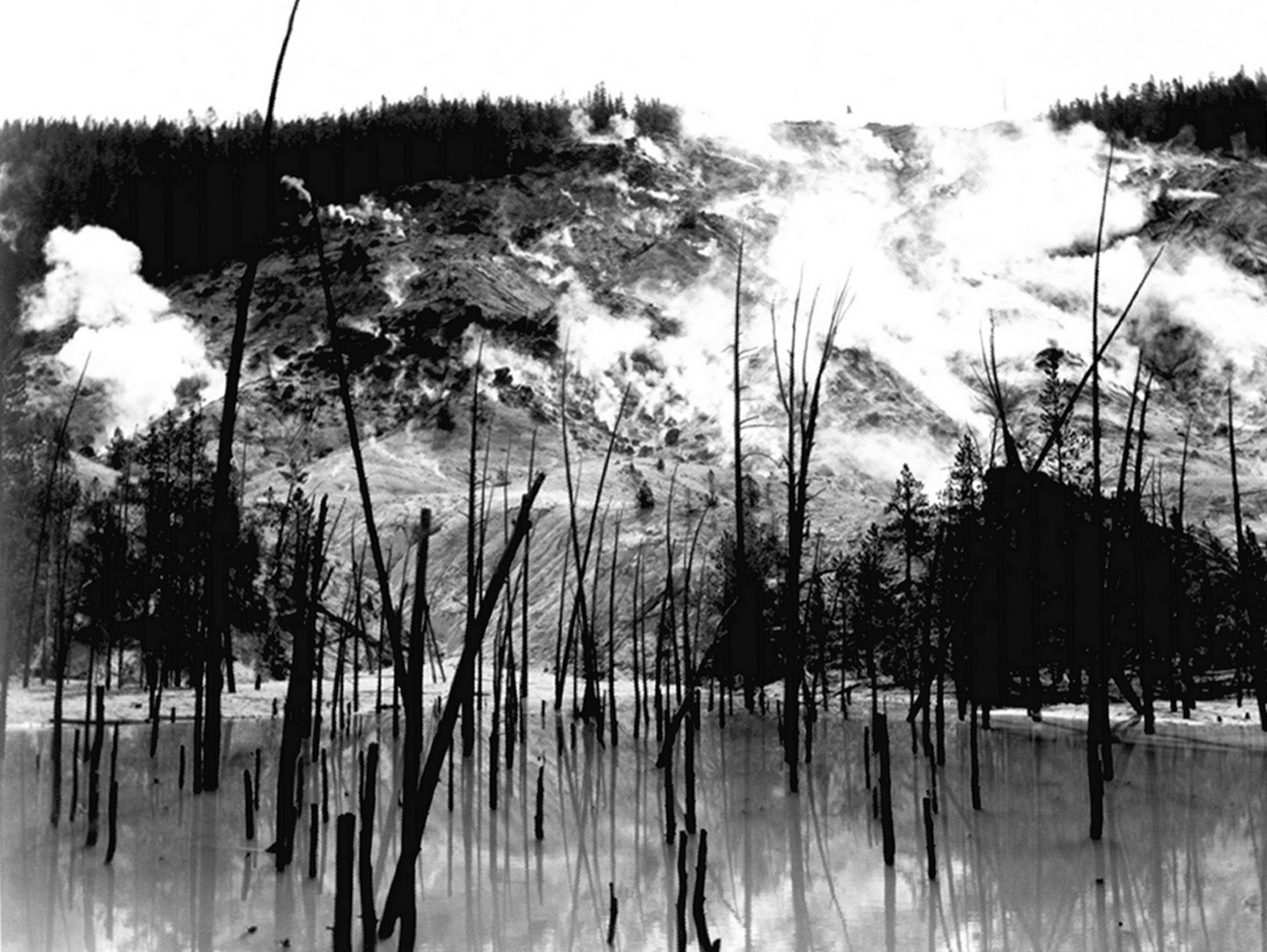|
Steamboat Geyser
Steamboat Geyser, in Yellowstone National Park's Norris Geyser Basin, is the world's tallest currently-active geyser. Steamboat Geyser has two vents, a northern and a southern, approximately apart. The north vent is responsible for the tallest water columns; the south vent's water columns are shorter. Prior to 1904, Waimangu Geyser, in New Zealand, had some taller eruptions capable of reaching , but in 1904, a landslide changed the local water table, and since then, Waimangu has not erupted. Excelsior Geyser in Yellowstone's Midway Geyser Basin, and Semi-Centennial Geyser just north of Roaring Mountain on the Grand Loop Road were reported to be as tall as Steamboat, both with eruptions reaching . However, Excelsior has not erupted since 1985, and now functions as a hot spring A hot spring, hydrothermal spring, or geothermal spring is a spring produced by the emergence of geothermally heated groundwater onto the surface of the Earth. The groundwater is heated either by shal ... [...More Info...] [...Related Items...] OR: [Wikipedia] [Google] [Baidu] |
Park County, Wyoming
Park County is a county in the U.S. state of Wyoming. As of the 2020 United States Census, the population was 29,624. The county seat is Cody. Park County is a major tourism destination. The county has over 53 percent of Yellowstone National Park's land area. Many attractions abound, including the Buffalo Bill Historical Center, the Cody Stampede Rodeo, the Ghost Town of Kirwin, and the western museum Old Trail Town. History Wyoming gained separate territorial status in 1868. Before that, most of the state's area was included in either Laramie County (part of the Dakota Territory) or as unorganized territory within the Dakota Territory. Wyoming Territory was established on July 25, 1868, at which time Laramie County was assigned to this jurisdiction. The area now known as Park County was established as Carter County, then Sweetwater County. In 1884 it was assigned to Fremont County; this continued until 1896, when it was assigned to Big Horn County. Wyoming achieved statehood ... [...More Info...] [...Related Items...] OR: [Wikipedia] [Google] [Baidu] |
Roaring Mountain
Roaring Mountain () is in Yellowstone National Park in the U.S. state of Wyoming. Roaring Mountain was named for the numerous fumarole A fumarole (or fumerole) is a vent in the surface of the Earth or other rocky planet from which hot volcanic gases and vapors are emitted, without any accompanying liquids or solids. Fumaroles are characteristic of the late stages of volcani ...s on the western slope of the peak which during the early 1900s were loud enough to be heard for several miles. Roaring Mountain is north of Norris Geyser Basin and south of Obsidian Cliff and is easily seen from park roads. References {{Mountains of Wyoming Geothermal features of Yellowstone National Park Mountains of Yellowstone National Park Mountains of Wyoming Geothermal features of Park County, Wyoming Mountains of Park County, Wyoming ... [...More Info...] [...Related Items...] OR: [Wikipedia] [Google] [Baidu] |
Yellowstone Volcano Observatory
The Yellowstone Volcano Observatory (YVO) is a volcano observatory that primarily monitors the Yellowstone Caldera in Yellowstone National Park in the United States. The observatory's jurisdiction also includes volcanic centers in the states of Colorado, Utah, Arizona, and New Mexico. As with other U.S. volcano observatories, it is funded through the United States Geological Surveybr>Volcano Hazards Program The observatory consists of 9 member agencies: ThUSGS thUniversity of Utah thUniversity of Wyoming th Montana Bureau of Mines and Geology th Wyoming State Geological Survey th [...More Info...] [...Related Items...] OR: [Wikipedia] [Google] [Baidu] |
National Park Service
The National Park Service (NPS) is an agency of the United States federal government within the U.S. Department of the Interior that manages all national parks, most national monuments, and other natural, historical, and recreational properties with various title designations. The U.S. Congress created the agency on August 25, 1916, through the National Park Service Organic Act. It is headquartered in Washington, D.C., within the main headquarters of the Department of the Interior. The NPS employs approximately 20,000 people in 423 individual units covering over 85 million acres in all 50 states, the District of Columbia, and US territories. As of 2019, they had more than 279,000 volunteers. The agency is charged with a dual role of preserving the ecological and historical integrity of the places entrusted to its management while also making them available and accessible for public use and enjoyment. History Yellowstone National Park was created as the first national par ... [...More Info...] [...Related Items...] OR: [Wikipedia] [Google] [Baidu] |
B MG 2505A
B, or b, is the second letter of the Latin-script alphabet, used in the modern English alphabet, the alphabets of other western European languages and others worldwide. Its name in English is '' bee'' (pronounced ), plural ''bees''. It represents the voiced bilabial stop in many languages, including English. In some other languages, it is used to represent other bilabial consonants. History Old English was originally written in runes, whose equivalent letter was beorc , meaning "birch". Beorc dates to at least the 2nd-century Elder Futhark, which is now thought to have derived from the Old Italic alphabets' either directly or via Latin . The uncial and half-uncial introduced by the Gregorian and Irish missions gradually developed into the Insular scripts' . These Old English Latin alphabets supplanted the earlier runes, whose use was fully banned under King Canute in the early 11th century. The Norman Conquest popularised the Carolingian half-uncial forms which lat ... [...More Info...] [...Related Items...] OR: [Wikipedia] [Google] [Baidu] |
Hot Spring
A hot spring, hydrothermal spring, or geothermal spring is a spring produced by the emergence of geothermally heated groundwater onto the surface of the Earth. The groundwater is heated either by shallow bodies of magma (molten rock) or by circulation through faults to hot rock deep in the Earth's crust. In either case, the ultimate source of the heat is radioactive decay of naturally occurring radioactive elements in the Earth's mantle, the layer beneath the crust. Hot spring water often contains large amounts of dissolved minerals. The chemistry of hot springs ranges from acid sulfate springs with a pH as low as 0.8, to alkaline chloride springs saturated with silica, to bicarbonate springs saturated with carbon dioxide and carbonate minerals. Some springs also contain abundant dissolved iron. The minerals brought to the surface in hot springs often feed communities of extremophiles, microorganisms adapted to extreme conditions, and it is possible that life on Earth had its ... [...More Info...] [...Related Items...] OR: [Wikipedia] [Google] [Baidu] |
Semi-Centennial Geyser
Semi-Centennial Geyser is located just north of Roaring Mountain in Yellowstone National Park in the U.S. state of Wyoming Wyoming () is a U.S. state, state in the Mountain states, Mountain West subregion of the Western United States. It is bordered by Montana to the north and northwest, South Dakota and Nebraska to the east, Idaho to the west, Utah to the south .... Situated next to the Grand Loop Road, the geyser was first noticed when it had a few small eruptions in 1919. A few years later at 6:40am on August 14, 1922 the geyser erupted in the first of a series of increasingly violent eruptions. By the afternoon on the same day reports stated that the ejected water was exceeding in height. By the evening of the 14th, the geyser had scattered debris and rocks a distance of from the crater. Short lived, Semi-Centennial Geyser has been quiet since and a small pool of water now exists where the geyser erupted. As the geyser showed its biggest activity in 1922, the 50th anni ... [...More Info...] [...Related Items...] OR: [Wikipedia] [Google] [Baidu] |
Yellowstone National Park
Yellowstone National Park is an American national park located in the western United States, largely in the northwest corner of Wyoming and extending into Montana and Idaho. It was established by the 42nd U.S. Congress with the Yellowstone National Park Protection Act and signed into law by President Ulysses S. Grant on March 1, 1872. Yellowstone was the first national park in the U.S. and is also widely held to be the first national park in the world. The park is known for its wildlife and its many geothermal features, especially the Old Faithful geyser, one of its most popular. While it represents many types of biomes, the subalpine forest is the most abundant. It is part of the South Central Rockies forests ecoregion. While Native Americans have lived in the Yellowstone region for at least 11,000 years, aside from visits by mountain men during the early-to-mid-19th century, organized exploration did not begin until the late 1860s. Management and control of the park ... [...More Info...] [...Related Items...] OR: [Wikipedia] [Google] [Baidu] |
Geothermal Areas Of Yellowstone
The geothermal areas of Yellowstone include several geyser basins in Yellowstone National Park as well as other geothermal features such as hot springs, mud pots, and fumaroles. The number of thermal features in Yellowstone is estimated at 10,000. A study that was completed in 2011 found that a total of 1,283 geysers have erupted in Yellowstone, 465 of which are active during an average year. These are distributed among nine geyser basins, with a few geysers found in smaller thermal areas throughout the Park. The number of geysers in each geyser basin are as follows: Upper Geyser Basin (410), Midway Geyser Basin (59), Lower Geyser Basin (283), Norris Geyser Basin (193), West Thumb Geyser Basin (84), Gibbon Geyser Basin (24), Lone Star Geyser Basin (21), Shoshone Geyser Basin (107), Heart Lake Geyser Basin (69), other areas (33). Although famous large geysers like Old Faithful are part of the total, most of Yellowstone's geysers are small, erupting to only a foot or two. The ... [...More Info...] [...Related Items...] OR: [Wikipedia] [Google] [Baidu] |
Excelsior Geyser
Excelsior Geyser Crater, formerly known as Excelsior Geyser, is a dormant fountain-type geyser in the Midway Geyser Basin of Yellowstone National Park in the United States. Excelsior was named by the Hayden Geological Survey of 1871. Description The Excelsior Geyser pool discharges 4,000 to 4,500 gallons (15,100–17,000 L) of water per minute directly into the Firehole River. In the late 19th century (and possibly 1901), it was an active geyser that erupted frequently. Most eruptions were about 100 feet high, although some exceeded in both height and width. It is believed that the powerful eruptions damaged its internal plumbing system, and it now boils as a productive hot spring A hot spring, hydrothermal spring, or geothermal spring is a spring produced by the emergence of geothermally heated groundwater onto the surface of the Earth. The groundwater is heated either by shallow bodies of magma (molten rock) or by circ ... most of the time. Activity In 1985, Excelsior ... [...More Info...] [...Related Items...] OR: [Wikipedia] [Google] [Baidu] |




.jpg)
